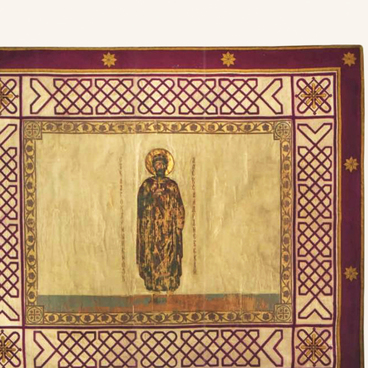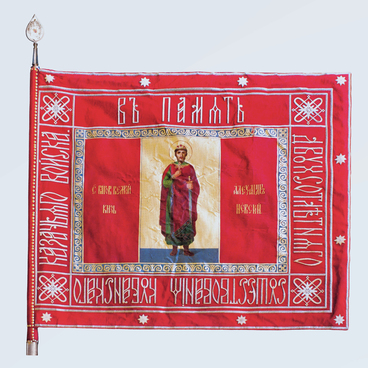Zakhary Chepiha was the second ataman of the Kuban Cossacks after Sidor Bely. Before taking up this position, he served in the Zaporozhian Sich. He first arrived there about 1750, when he was 25 years old. The Cossack was assigned to the Kislyakovsky kurin (a village of 100 houses). Starting from 1767, Zakhary Chepiha was in charge of the guards on the border at Perevizska Palanka. Palanka is the name of the administrative-territorial unit in the Zaporizhian Sich. The Nova Sich had from 5 to 11 palankas, each of them under the guidance of a palanka colonel. All of the palanka colonels were appointed by the Cossack community called ‘kish’.
When the Zaporizhian Sich was abolished in 1775, Zakhary Chepiha served as colonel of the Protovchanskaya palanka. By this time he ordered for himself a personal banner of silk fabric, which was sewn by hand and painted in tempera (a set of paints based on dry natural pigments and egg yolk). On one half of the banner was depicted an Orthodox cross and on the other were a crescent and stars.
After the disbandment of the Zaporizhian Sich, Zakhary Chepiha kept the regimental banner. In 1787, he brought it to the meeting with Prince Grigory Potemkin-Tauricheski. The prince suggested that Zakhary Chepiha, Sidor Bely, and Anton Golovatsky gather a group of volunteer Cossacks, and this was the beginning of the Black Sea Cossack Host.
Zakhary Chepiha participated in many major battles during the Russo-Turkish War of 1787–1792. His Cossack units became well-known during the capture of the famous Turkish fortress of Ismail and also in the battles of Ochakov, Bender, Akkerman, and Hajibey. Empress Catherine the Great awarded him a saber decorated with precious stones for his military successes. After the death of Sidor Bely in the naval battle near Ochakov in 1787, Zakhary Chepiha became the ataman of the Black Sea Cossack Host.
Zakhary Chepiha died on January 14, 1797, in Yekaterinodar (modern-day Krasnodar). After his death, the ataman’s banner passed from hand to hand for several decades, and in 1842, it was delivered to the Administration of the Yeisk Military District. There it was kept for more than 50 years until in 1895 it was transported to the Army Headquarters. By this time, the banner was heavily damaged, and the Cossacks did not remember who it used to belong to. The banner was given to the archivist of the Army Archive. Among many documents, he found the records of Lieutenant-Colonel Jakov Kuharenko from 1845 with a detailed description of the banner. This is how it was possible to discover the origin of the banner. On December 17, 1895, the banner of Zakhary Chepiha was included in the list of the Cossack regalia.
When the Zaporizhian Sich was abolished in 1775, Zakhary Chepiha served as colonel of the Protovchanskaya palanka. By this time he ordered for himself a personal banner of silk fabric, which was sewn by hand and painted in tempera (a set of paints based on dry natural pigments and egg yolk). On one half of the banner was depicted an Orthodox cross and on the other were a crescent and stars.
After the disbandment of the Zaporizhian Sich, Zakhary Chepiha kept the regimental banner. In 1787, he brought it to the meeting with Prince Grigory Potemkin-Tauricheski. The prince suggested that Zakhary Chepiha, Sidor Bely, and Anton Golovatsky gather a group of volunteer Cossacks, and this was the beginning of the Black Sea Cossack Host.
Zakhary Chepiha participated in many major battles during the Russo-Turkish War of 1787–1792. His Cossack units became well-known during the capture of the famous Turkish fortress of Ismail and also in the battles of Ochakov, Bender, Akkerman, and Hajibey. Empress Catherine the Great awarded him a saber decorated with precious stones for his military successes. After the death of Sidor Bely in the naval battle near Ochakov in 1787, Zakhary Chepiha became the ataman of the Black Sea Cossack Host.
Zakhary Chepiha died on January 14, 1797, in Yekaterinodar (modern-day Krasnodar). After his death, the ataman’s banner passed from hand to hand for several decades, and in 1842, it was delivered to the Administration of the Yeisk Military District. There it was kept for more than 50 years until in 1895 it was transported to the Army Headquarters. By this time, the banner was heavily damaged, and the Cossacks did not remember who it used to belong to. The banner was given to the archivist of the Army Archive. Among many documents, he found the records of Lieutenant-Colonel Jakov Kuharenko from 1845 with a detailed description of the banner. This is how it was possible to discover the origin of the banner. On December 17, 1895, the banner of Zakhary Chepiha was included in the list of the Cossack regalia.



